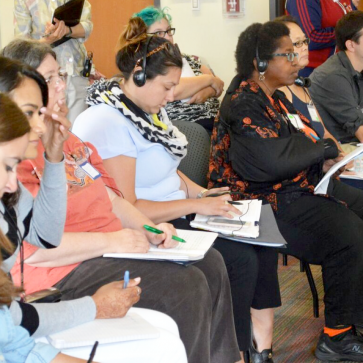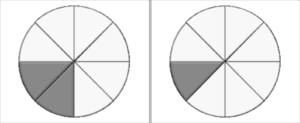Lesson Study works best with rich subject content. This course offers step-by-step support to conduct a Lesson Study cycle on fractions, by providing fractions resources and research to examine.

Fractions Task 2
Task 2 : Find two fractions between 1/2 and 1.
Discussion Questions:
- How did you solve the problem, and how might students solve the problem?
- What understandings and misunderstandings about fractions might this problem reveal?
- Look at the student solutions to Task 2. What do the student responses suggest that each student understands and does not understand about fractions?
- Do you notice any differences in the responses of students who used the basal textbook and the students who participated in the “Measure Up” curriculum?
Task 2 Student Solutions
| Student Response | Rationale |
| Student 1 1/4 1/5 | because 4 is bigger than 1 because 5 is bigger than 1 |
| Student 2 3/4 7/8 | are between 1/2 and 1. Both are missing one part. |
| Student 3 2/3 4/5 | 2 is more than 1 3 is more than 2 4 is more than 1 5 is more than 2 |
| Student Response | Rationale |
| Student 1 2/3 3/4 | If there is a lot of parts, there are smaller pieces. So you have to use a lot of them to get close to 1. So 2 out of 3 parts is close to 1 and so is 3 out of 4 parts |
| Student 2 5/8 7/8 | If you have 8 parts, then 4 parts are 1/2 so 5 parts and 7 parts are more then (sic) 1/2. But there (sic) not 1 because you need all the parts. |
| Student 3 5/9 6/10 | What I did was think of the number of parts and then what is haf (sic). Then I added one to it. |
What Makes Fractions So Difficult?
Like Jordan, many students feel that “there’s something weird about fractions.” The three tasks in this section shed some light on students’ challenges with fractions.There’s something weird about fractions. If the numerator, which is the top, is the same, the bigger the denominator the smaller the fraction. - Jordan, Grade 5 student
- Solve each task individually, and anticipate student thinking, before your team members share solutions. Each task is downloadable.
Fractions Task 1
Task 1 : Estimate the answer to 12/13+ 7/8. You will not have time to solve the problem using paper and pencil.
A) 1
B) 2
C) 19
D) 21
Discussion Questions:
- How did you solve the problem, and how might students solve the problem?
- What insights into fractions make quick work of solving this problem?
- Discuss why students chose each of the responses shown. Why do so many students find this problem difficult?
Task 1 Student Solutions
|
Answer Options |
Percent of Age 13 Students Who Chose Answer |
|
1 |
7% |
|
2 |
24% |
|
19 |
28% |
|
21 |
27% |
|
I don’t know |
14% |
Fractions Task 3
Task 3: Jim has 3/4 of a yard of string which he wishes to divide into pieces, each 1/8 of a yard long. How many pieces will he have?
A) 3
B) 4
C) 6
D) 8
Discussion Question:
- How did you solve the problem and how might students solve the problem?
- Look at the student solutions from a US national assessment and explain what 70% of responding 4th grade students might have been thinking when they answered the above question incorrectly.
Task 3 Student Solutions
| Answer Options | Percent of Age 13 Students Who Chose Answer |
| 3 | 19% |
| 4 | 30% |
| 6* | 27% |
| 8 | 21% |
| No response | 3% |
Common Challenges with Fractions
From solving the three different fraction tasks and considering student solutions, summarize your team’s insights so far about the question:
- What is difficult for students about fractions?
The table “What’s Hard About Fraction Number Sense” summarizes six challenges in building fraction number sense, with examples of student understanding of each. Read each challenge, imagine what your students might find difficult, and click the challenge to see examples.
Discuss as a team:
- Anything in the table that is puzzling or particularly interesting to you
- Anything that helps you understand student responses to the tasks 1-3 that you examined
Record in Section 3 of the Teaching-Learning Plan any insights you would especially like to remember related to student thinking about fractions.
What's Hard About Fraction Number Sense? (PDF)
| Challenge in Understanding Fractions | Example of Student Difficulty or Understanding |
A Fraction is a Number
|
|
Fractions Can Be Greater than One
|
|
Fractions Can Be Partitioned
|
|
What the Denominator Means
|
|
Knowing What is the Whole
|
|
Fraction Size
|
|
[*] Kerslake, D. (1986). Fractions: Children’s strategies and errors. A report of the strategies and errors in Concepts in Secondary Mathematics and Science Project. Windsor, England: NFER-Nelson. Behr, M.J. & Post, T.R. (1992). Teaching rational numbers and decimal concepts. In T.R. Post (Ed.), Teaching mathematics in grades K-8, research-based methods (pp. 201-248). Boston: Allyn and Bacon.

